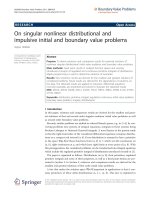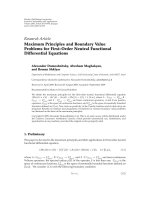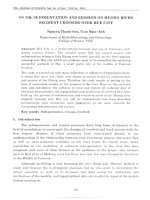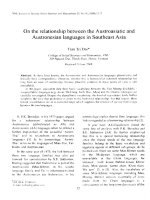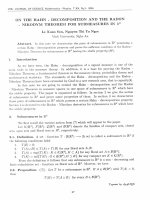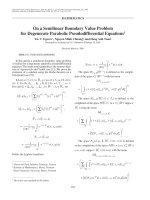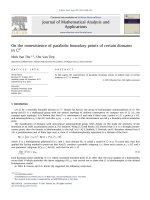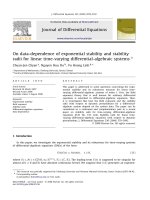DSpace at VNU: ON INITIAL AND BOUNDARY VALUE PROBLEMS FOR IMPLICIT DYNAMIC EQUATIONS ON TIME SCALES
Bạn đang xem bản rút gọn của tài liệu. Xem và tải ngay bản đầy đủ của tài liệu tại đây (584.35 KB, 14 trang )
Acta Math Vietnam
DOI 10.1007/s40306-013-0026-z
ON INITIAL AND BOUNDARY VALUE PROBLEMS
FOR IMPLICIT DYNAMIC EQUATIONS ON TIME
SCALES
Nguyen Chi Liem
Received: 29 December 2011 / Revised: 10 September 2012 / Accepted: 24 September 2012
© Institute of Mathematics, Vietnam Academy of Science and Technology (VAST) and Springer
Science+Business Media Singapore 2013
Abstract This paper is concerned with the index concept, the unique solvability of the
initial value problem, the two point boundary-value problem and Green’s function for a
class of linear implicit dynamic equations with index-1 on time scales. The results are a
generalization of the previous ones for differential and difference-algebraic equations.
Keywords Time scales · Implicit dynamic equation · Linear dynamic equation · Index ·
Boundary-value problem · Green’s function
Mathematics Subject Classification (2000) 39A11 · 34A09 · 65L80 · 65F20 · 34D20
1 Introduction
In the last decades, the theory of differential-algebraic equations (DAEs for short) has been
an intensively discussed field in both theory and practice. The general form of DAEs is
f t, x (t), x(t) = 0,
(1)
At x (t) = Bt x(t) + qt ,
(2)
and its linearization has the form
where A. and B. are given matrix functions. Equations (1) and (2) can be seen in many real
problems, such as in electric circuits, chemical reactions, vehicle systems, . . . .
If the matrices At are invertible for all t ∈ R, we can multiply both sides of (2) by A−1
t
to obtain an ordinary differential equation. However, in the case where there is at least one
t0 ∈ R such that At0 is singular, some further assumptions need to be posed. One of the ways
B
N.C. Liem ( )
Department of Mathematics, Mechanics and Informatics, Vietnam National University,
334 Nguyen Trai, Hanoi, Vietnam
e-mail:
N.C. LIEM
to investigate (2) is to introduce the index concept of the equation. Based on this concept,
we can study (2) by decomposing it into an ordinary differential equation and algebraic
relations. Results on the solvability of the Cauchy problem for (2) can be found in [10]; for
the boundary value problems, we can refer to [17].
Together with the theory of differential-algebraic equations, there has been a great interest in singular difference equations (SDEs) (also referred to as descriptor systems, implicit difference equations) because of their appearance in many practical areas, such as in
the Leontiev dynamic model of multisector economy, the Leslie population growth model,
singular discrete optimal control problems and so forth (see [6, 7]). On the other hand,
SDEs occur in a natural way of using discretization techniques for solving DAEs and partial differential-algebraic equations. . . , which have already attracted much attention of researchers (cf. [6, 10, 13]).
Bondarenko and his colleagues in [5] considered a special class of implicit nonautonomous difference equation T (n)x(n + 1) + x(n) = f (n), where T (n) are degenerate matrices, and established the solvability of initial value problems (IVPs) and periodic
boundary-value problems (BVPs) for this special class of SDEs.
The index notion for linear SDEs with time-varying coefficients
An x(n + 1) = Bn x(n) + qn
(3)
was introduced in [8, 16] and the solvability of IVPs as well as multipoint BVPs are studied
in [1, 3]. Later on, the index notion has been extended to nonlinear cases f (n, x(n + 1),
x(n)) = 0 [2].
There is a close relation between linear SDEs and linear DAEs, namely, the explicit Euler
method applied to a linear index-1 DAE leads to a linear index-1 SDE (see [1, 3]) and the
unique solutions of the discretized IVP/BVP converge to the solutions of the corresponding
continuous problems.
Further, in recent years, to unify the continuous and the discrete analyses or to describe
the process of numerical calculation with non-constant steps, a new theory was born and is
more and more extensively concerned, that is, the theory of the analysis on time scales. The
most popular examples of time scales are T = R and T = Z. Using the “language” of time
scales, we rewrite (2) and (3) in the form
At x Δ = Bt x + qt ,
(4)
or in the general form
f t, x Δ (t), x(t) = 0,
with t in time scale T and Δ being the derivative operator on T.
A natural question is whether the existing results for (2) and (3) can be extended and
unified for the implicit dynamic equations of the form (4). The purpose of this paper is to
answer a part of that question. We will study the solvability of the Cauchy problem and
some matters concerning the boundary-value problem of (4).
The organization of this paper is as follows. In Sect. 2 we summarize some results about
the analysis on time scales. In Sect. 3, we introduce the index-1 concept and deal with the
Cauchy problem of linear implicit dynamic equations (4) (LIDEs). The technique we use
in this section is somewhat similar to the one in [8, 10]. However, we need some improvements because of the complicated structure of a time scale. Section 4 deals with the solution
uniqueness for the two point boundary-value problem and constructs the Green function.
IMPLICIT DYNAMIC EQUATIONS ON TIME SCALES
2 Preliminaries
This section surveys some notions on the theory of the analysis on time scales which was
introduced by Stefan Hilger in 1988 [11]. A time scale is a nonempty closed subset of
the real numbers R, and we usually denote it by the symbol T. We assume throughout
that a time scale T is endowed with the topology inherited from the real numbers with
the standard topology. We define the forward jump operator and the backward jump operator σ, ρ : T → T by σ (t) = inf{s ∈ T : s > t} (supplemented by inf ∅ = sup T) and
ρ(t) = sup{s ∈ T : s < t} (supplemented by sup ∅ = inf T). The graininess μ : T → R+ ∪ {0}
is given by μ(t) = σ (t) − t . A point t ∈ T is said to be right-dense if σ (t) = t and t < sup T,
right-scattered if σ (t) > t , left-dense if ρ(t) = t and t > inf T, left-scattered if ρ(t) < t , and
isolated if t is right-scattered and left-scattered. For every a, b ∈ T, by [a, b] we mean the
set {t ∈ T : a t b}. The set Tk is defined to be T if T does not have a left-scattered maximum; otherwise it is T without this left-scattered maximum. Let f be a function defined
on T, valued in Rm . We say that f is delta differentiable (or simply: differentiable) at t ∈ Tk
provided there exists a vector f Δ (t) ∈ Rm , called the derivative of f , such that for all > 0
there is a neighborhood V around t with f (σ (t)) − f (s) − f Δ (t)(σ (t) − s)
|σ (t) − s|
for all s ∈ V . If f is differentiable for every t ∈ Tk , then f is said to be differentiable on T.
If T = R then delta derivative is f (t) from continuous calculus; if T = Z, the delta derivative is the forward difference, Δf , from discrete calculus. A function f defined on T is
rd-continuous if it is continuous at every right-dense point and if the left-sided limit exists
at every left-dense point. The set of all rd-continuous functions from T to a Banach space
X is denoted by Crd (T, X). A matrix function f from T to Rm×m is said to be regressive if
det(I + μ(t)f (t)) = 0 for every t ∈ Tk .
Theorem 1 (See [4]) Let A(·) be an rd-continuous m × m-matrix function. Then, for any
t0 ∈ Tk , the IVP
x Δ = A(t)x,
x(t0 ) = x0
(5)
t0 . Further, if A(·) is regressive, this solution exists
has a unique solution x(·) defined on t
on t ∈ Tk .
The solution of the corresponding matrix-valued IVP X Δ (t) = A(t)X(t), X(t0 ) = I ,
which is called the Cauchy operator of the dynamic equation (5) and denoted by ΦA (t, t0 ),
always exists for t t0 , even A(·) is not regressive (see [12, 19]). If we suppose further that
A(·) is regressive, the Cauchy operator ΦA (t, t0 ) is defined for all t, t0 ∈ Tk .
It is seen that any solution x(·) of the dynamic equation (5) can be written as x(·) =
ΦA (·, t0 )x0 and the cocycle property
ΦA (t, τ ) = ΦA (t, s)ΦA (s, τ )
is valid for all τ s t .
t
If A(t) commutes with its integral t0 A(s)Δs, (in particular, A(t) ≡ constant matrix
satisfies this straightforwardly) then we denote eA (t, t0 ) instead of ΦA (t, t0 ).
Theorem 2 (Constant variation formula, see [12]) Let A : Tk → Rm×m and f : Tk × Rm →
Rm be rd-continuous and there exists a solution x(t), t t0 for the dynamic equation x Δ =
A(t)x + f (t, x), x(t0 ) = x0 . Then
t
x(t) = ΦA (t, t0 )x0 +
ΦA t, σ (s) f s, x(s) Δs,
t0
t
t0 .
(6)
N.C. LIEM
We refer to [12, 18] for more information on analysis on time scales.
3 Linear implicit dynamic equations on time scales
Let T be a time scale. We consider the linear implicit dynamic equation of the form
At x Δ = B t x + qt ,
t ∈ T.
(7)
The homogeneous equation associated to (7) is
At x Δ = Bt x,
(8)
where A. , B. ∈ Crd (Tk , Rm×m ), q. ∈ Crd (Tk , Rm ). In the case where the matrices At are into obtain an ordinary
vertible for every t ∈ T, we can multiply both sides of (7) by A−1
t
dynamic equation
−1
x Δ = A−1
t B t x + A t qt ,
t ∈ T,
which has been well studied. If there is at least a t such that At is singular, we cannot solve
explicitly the leading term x Δ . In fact, we are concerned with a so-called ill-posed problem
where the solutions of the Cauchy problem may exist only on a submanifold or even they
do not exist. One of the ways to solve this equation is to impose some further assumptions
stated under the form of indices of equation.
We introduce the so-called index-1 of (7). Suppose that rank At = r for all t ∈ T and
let Tt ∈ GL(Rm ) be such that Tt |ker At is an isomorphism between ker At and ker Aρ(t) ;
T. ∈ Crd (Tk , Rm×m ). Let Qt be a projector onto ker At satisfying Q. ∈ Crd (Tk , Rm×m ). We
can find such operators Tt and Qt in the following way: let At possess a singular value
decomposition
At = Ut Σt Vt ,
where Ut , Vt are orthogonal matrices and Σt is a diagonal matrix with singular values
σt1 σt2 · · · σtr > 0 on its main diagonal. Since A. ∈ Crd (Tk , Rm×m ), in the above
decomposition of At we can choose Vt ∈ Crd (Tk , Rm×m ) (see [7]). Hence, by putting
Qt = Vt diag(0, Im−r )Vt and Tt = Vρ(t) Vt , we obtain Qt and Vt as the requirement.
Let Qt and Tt be such matrices and put Pt := I − Qt . We suppose further that Qρ(t) is
rd-continuously differentiable on Tk .
It is known that ρ(σ (t)) = t if and only if t is not right-dense and left-scattered at the
same time. We consider the case where t = t0 is right-dense and left-scattered at the same
time (ρ(t0 ) < t0 = σ (t0 )). Then, from the continuity of Qρ(·) and Q· at t0 we get the equalities limt→t0 Qρ(t) = Qρ(t0 ) and limt→t0 Qρ(t) = Qt0 . Therefore, Qρ(t0 ) = Qt0 .
Thus, by the above assumptions of the projector Qt we always have Qρ(σ (t)) = Qt for all
t ∈ Tk .
From the relation
Pρ(t) x(t)
Δ
= Pρ(σ (t)) x Δ (t) + (Pρ(t) )Δ x(t) = Pt x Δ (t) + (Pρ(t) )Δ x(t),
for all t ∈ Tk , we get
At x Δ (t) = At Pt x Δ (t) = At Pρ(t) x(t)
Δ
− (Pρ(t) )Δ x(t) .
IMPLICIT DYNAMIC EQUATIONS ON TIME SCALES
Therefore, the implicit dynamic equation (7) can be rewritten as
At (Pρ(t) x)Δ = At (Pρ(t) )Δ + Bt x + qt ,
t ∈ Tk .
Thus, we should look for solutions of (7) from the space CN1 :
CN1 Tk , Rm = x(·) ∈ Crd Tk , Rm :Pρ(t) x(t) is differentiable at every t ∈ Tk .
Note that CN1 does not depend on the choice of the projector function since the relations
Pt Pt = Pt and Pt Pt = Pt are true for each two projectors Pt and Pt along the space ker At .
Let
St = x ∈ Rm : Bt x ∈ imAt .
Under these notations, we have:
Lemma 1 [9] The following assertions are equivalent
1. kerAρ(t) ∩ St = {0},
2. The matrix Gt = At − Bt Tt Qt is nonsingular,
3. Rm = ker Aρ(t) ⊕ St for all t ∈ Tk .
Lemma 2 [9] Suppose that the matrix Gt is nonsingular. Then we have the following assertions:
Pt = G−1
t At ,
Qt =
(9)
−G−1
t B t Tt Q t ,
− Tt Qt G−1
t Bt
(10)
is the projector onto ker Aρ(t) along St ,
−1
Pt G−1
t Bt = Pt Gt Bt Pρ(t) ,
Qt G−1
t Bt
=
Tt Qt G−1
t
Qt G−1
t Bt Pρ(t)
(11)
(12)
− Tt
−1
Qρ(t) ,
does not depend on the choice of Tt and Qt .
(13)
(14)
Definition 1 The LIDE (7) is said to be of index-1 if for all t ∈ Tk , the following conditions
hold:
(i) rankAt = r= constant (1
(ii) ker Aρ(t) ∩ St = {0}.
r
m − 1),
Assume that (7) is of index-1.
We now describe briefly the decomposition technique for (7).
By Lemma 1, since (7) has index-1, Gt is nonsingular for all t ∈ Tk . Multiplying (7) by
−1
Pt G−1
t and Qt Gt , respectively, yields
Δ
−1
−1
Pt G−1
t A t x = P t G t B t x + P t G t qt ,
−1
Δ
−1
Qt Gt At x = Qt Gt Bt x + Qt G−1
t qt .
Applying (9), we have
−1
Pt x Δ = Pt G−1
t B t x + P t G t qt ,
−1
−1
0 = Qt G t B t x + Qt G t qt .
(15)
N.C. LIEM
Due to (12) and (13), (15) becomes
⎧
Δ
Δ
−1
−1
⎪
⎨(Pρ(t) x) = (Pρ(t) ) (I + Tt Qt Gt Bt )(Pρ(t) x) + Pt Gt Bt (Pρ(t) x)
Δ
−1
+ (Pt + (Pρ(t) ) Tt Qt )Gt qt ,
⎪
⎩
−1
Qρ(t) x = Tt Qt G−1
t Bt Pρ(t) x + Tt Qt Gt qt .
(16)
Therefore, with u(t) := Pρ(t) x(t), v(t) = Qρ(t) x(t), (16) becomes an ordinary dynamic
equation on T
−1
Δ
−1
uΔ = (Pρ(t) )Δ I + Tt Qt G−1
t Bt u + Pt Gt Bt u + Pt + (Pρ(t) ) Tt Qt Gt qt ,
(17)
and an algebraic relation
−1
v = Tt Qt G−1
t B t u + Tt Q t G t q t .
(18)
Let t0 ∈ Tk . Solving u(t) from (17) with the initial condition u(t0 ) = Pρ(t0 ) x0 and using
the relation (18), we get an expression of the solutions of the index-1 LIDE (7) x(t) =
u(t) + v(t) for t t0 .
Inspired by the above decoupling procedure, we state initial conditions for the index-1
LIDE (7) as
Pρ(t0 ) x(t0 ) − x0 = 0,
x0 ∈ Rm given.
(19)
It follows that
u(t0 ) = Pρ(t0 ) x(t0 ) = Pρ(t0 ) x0 ,
but we do not expect
x(t0 ) = x0
as in the case of ordinary dynamic equations on time scales.
Denote Qtcan := −Tt Qt G−1
t Bt , Ptcan := I − Qtcan . By (11), Qtcan projects onto ker Aρ(t)
along St and is called the canonical projector for the index-1 case. Note that Qtcan is rdcontinuous and independent from the choice of Qt and Tt . The solutions of (7) with the
initial condition (19) are represented by
−1
x(t) = Pρ(t) x(t) + Qρ(t) x(t) = (I + Tt Qt G−1
t Bt )u + Tt Qt Gt qt
= Ptcan u(t) + Tt Qt G−1
t qt ,
t
(20)
t0 ,
1
where u ∈ Crd
solves from the inherent ordinary dynamic equation (17) with the initial
condition u(t0 ) = Pρ(t0 ) x0 .
By multiplying both sides of the homogeneous equation associated to (17) with Qt and
using the fact that
0 = (Qρ(t) Pρ(t) )Δ = Qt (Pρ(t) )Δ + (Qρ(t) )Δ Pρ(t)
=⇒
Qt (Pρ(t) ) = −(Qρ(t) ) Pρ(t) ,
Δ
Δ
one has
Qt uΔ = Qt (Pρ(t) )Δ Ptcan u = −(Qρ(t) )Δ Pρ(t) Ptcan u = −(Qρ(t) )Δ Pρ(t) u.
IMPLICIT DYNAMIC EQUATIONS ON TIME SCALES
Further, since Qt uΔ = (Qρ(t) u)Δ − (Qρ(t) )Δ u we get
(Qρ(t) u)Δ = (Qρ(t) )Δ (Qρ(t) u).
Hence, if Qρ(t0 ) u(t0 ) = 0 then Qρ(t) u(t) = 0 for all t
property:
if x(t0 ) ∈ im Pρ(t0 )
t0 . Therefore, (17) has the invariant
then x(t) ∈ im Pρ(t)
for all t ∈ Tk .
(21)
Consider the homogeneous equation (8), i.e., qt ≡ 0. Let Φ0 (t, t0 ) be the matrix solution
of the dynamic equation
−1
(Φ0 (t, t0 ))Δ = (Pρ(t) )Δ (I + Tt Qt G−1
t Bt )Φ0 (t, t0 ) + Pt Gt Bt Φ0 (t, t0 ),
Φ0 (t0 , t0 ) = I.
t
t0 ,
Then, due to (20), the solution of the matrix equation
At (Φ(t, t0 ))Δ = Bt Φ(t, t0 ),
Pρ(t0 ) (Φ(t0 , t0 ) − I ) = 0
t
t0 ,
can be expressed by the formula
Φ(t, t0 ) = I + Tt Qt G−1
t Bt Φ0 (t, t0 )Pρ(t0 ) = Ptcan Φ0 (t, t0 )Pρ(t0 ) ,
t
t0 .
(22)
It is easily verified that ker Φ(t, t0 ) = ker Aρ(t0 ) and im Φ(t, t0 ) = im Ptcan = St hold. The
matrix solution Φ(t, t0 )t t0 is called the Cauchy operator of (8).
Further, due to the invariant property (21) of the solutions of (17), we have
Pρ(t) Φ(t, s) = Pρ(t) Ptcan Φ0 (t, s)Pρ(s) = Φ0 (t, s)Pρ(s) ,
t
s.
(23)
Therefore
Φ(t, s)Φ(s, τ ) = Φ(t, τ )
for all τ
s
t,
and the unique solution of (7) with the initial condition (19) can be given by the constant
variation formula
x(t) = Ptcan Φ0 (t, t0 )Pρ(t0 ) x0
t
+
Ptcan Φ0 t, σ (s) Pρ(σ (s)) Ps + (Pρ(s) )Δ Ts Qs G−1
s qs Δs
t0
+ Tt Qt G−1
t qt ,
t
t0 ,
or equivalently
t
x(t) = Φ(t, t0 )Pρ(t0 ) x0 +
Φ t, σ (s) Ps + (Pρ(s) )Δ Ts Qs G−1
s qs Δs
t0
+ Tt Qt G−1
t qt ,
t
(24)
t0 .
Now suppose that u = Pρ(t) x satisfies the homogeneous equation associated (17) corresponding to some operators Tt and Qt , i.e.,
(Pρ(t) x)Δ = (Pρ(t) )Δ Ptcan Pρ(t) x + Pt G−1
t Bt Pρ(t) x.
N.C. LIEM
Let Tt be another linear transformation from Rm onto Rm such that Tt |ker At is an isomorphism between ker At and ker Aρ(t) and Qt be a projector onto ker At such that Qt is
rd-continuous and Qρ(t) is rd-continuously differentiable. By denoting Pt = I − Qt , Gt =
At − Bt Tt Qt , we have
(Pρ(t) x)Δ = (Pρ(t) Pρ(t) x)Δ
= Pt (Pρ(t) x)Δ + (Pρ(t) )Δ Pρ(t) x
Δ
= Pt (Pρ(t) )Δ Ptcan Pρ(t) x + Pt G−1
t Bt Pρ(t) x + (Pρ(t) ) Pρ(t) x
= (Pρ(t) Pρ(t) )Δ Ptcan Pρ(t) Pρ(t) x − (Pρ(t) )Δ Pρ(t) Ptcan Pρ(t) x
Δ
+ Pt G−1
t Bt Pρ(t) x + (Pρ(t) ) Pρ(t) x
= (Pρ(t) )Δ Ptcan Pρ(t) x − (Pρ(t) )Δ Pρ(t) x
Δ
+ Pt G−1
t Bt Pρ(t) x + (Pρ(t) ) Pρ(t) x
= (Pρ(t) )Δ Ptcan Pρ(t) x + Pt G−1
t Bt Pρ(t) x.
−1
Moreover, it is easy to prove that Pt G−1
t = Pt Gt which implies
−1
−1
−1
Pt G−1
t Bt Pρ(t) x = Pt Gt Bt Pρ(t) x = Pt Gt Bt Pρ(t) Pρ(t) x = Pt Gt Bt Pρ(t) x.
Therefore we obtain
(Pρ(t) x)Δ = (Pρ(t) )Δ Ptcan Pρ(t) x + Pt G−1
t Bt Pρ(t) x.
Furthermore, we also have the relation
Qρ(t) x = −Qtcan Pρ(t) x
⇒
Qρ(t) x = −Qtcan Pρ(t) x.
This shows that the Cauchy operator of (8) does not depend on the choice of Tt and Qt , and
hence neither the expression of x by (24).
Consider the case where the right-hand side of the homogeneous equation associated to
(17), i.e., the matrix
At = (Pρ(t) )Δ Ptcan + Pt G−1
t Bt ,
is regressive (obviously, At is rd-continuous). With this assumption, the inherent dynamic
equation (17) has a unique solution defined on Tk . Thus,
Theorem 3 Given an index-1 LIDE (7), then
1. for each t0 ∈ Tk , x0 ∈ Rm , q. ∈ Crd (Tk , Rm ), the LIDE (7) with the initial condition (19)
is uniquely solvable for t t0 ,
2. further, with the assumption At to be regressive, exactly one solution of the homogeneous
equation x(t) of (8) passes through each x0 ∈ St0 at t0 .
Remark 1
1. When T = R (ρ(t) = t for all t ∈ R) we choose Tt = −I to see the result mentioned in
[10]. For the case T = Z, the result can be seen in [3].
IMPLICIT DYNAMIC EQUATIONS ON TIME SCALES
2. On the solvability of IVP for the quasi-linear implicit dynamic equations At x Δ = Bt x +
f (t, x), with small perturbation f (t, x) and for the equations At x Δ = f (t, x), with the
assumption of differentiability for f (t, x), we can refer to [9].
To finish this section, we give an example.
∞
k=0 [2k, 2k
Example 1 Consider the time scale T =
qt , with
At =
1
t
1
,
t
Bt =
t −1
0
+ 1] and the equation At x Δ = Bt x +
t −1
,
−1
qt =
1
.
2
We have ker At = span{(1, −1)T }, rank At = 1 for all t ∈ T. It is easy to verify that Qt =
1 1 −1
is a projector onto ker At . Let us choose Tt = I and observe that
2 −1 1
1
t −1
−
t
0
1
t
G t = A t − B t Tt Q t =
t −1 1 1
−1 2 −1
1
−1
=
1
t−
1
2
1
t+
1
2
.
Since det Gt = 1 = 0, (7) has index-1. We get
t + 12
−t + 12
G−1
t =
Tt Qt G−1
t Bt =
t −2
,
−t + 2
Tt Qt G−1
t qt =
Note that At =
−1
,
1
1 t−1 t−1
2 t−1 t−1
Ptcan =
t2 − t
−t 2 + t
t2 − t + 1
−t 2 + t
t2 − t + 1
,
−t 2 + t − 1
t2 − t + 1
.
−t 2 + t
is regressive (and rd-continuous). Indeed,
det I + μ(t)At =
1
2t
if t ∈
if t ∈
∞
k=0 [2k, 2k + 1)
∞
k=0 {2k + 1}
=0
for all t ∈ T.
Therefore the equation At x Δ = Bt x + qt with the initial condition Pρ(t0 ) (x(t0 ) − x0 ) = 0 is
uniquely solvable on Tk and its solution is represented by
x = Ptcan u + Tt Qt G−1
t qt
=
t2 − t + 1
−t 2 + t
t2 − t + 1
t −2
u+
,
−t 2 + t
−t + 2
t−1 t−1
→ uΔ =
where u satisfies uΔ = 12 t−1
t−1+
Pρ(t0 ) x0 .
Put h(t) := 12 (t − 1), we can find
1 t−1 t−1
2 t−1 t−1
, also the initial condition u(t0 ) =
t
Φ0 (t, t0 ) =
e2h (t, t0 ) − t0 e2h (t, σ (s))h(s)Δs
t
e2h (t, t0 ) − 1 − t0 e2h (t, σ (s))h(s)Δs
t
t0
e2h (t, σ (s))h(s)Δs
t
1 + t0 e2h (t, σ (s))h(s)Δs
∀t, t0 ∈ Tk .
Therefore the Cauchy operator of the above equation is
Φ(t, t0 ) = Ptcan Φ0 (t, t0 )Pρ(t0 ) = 2e2h (t, t0 )Ptcan .
N.C. LIEM
4 Boundary value problem and Green’s function
By using the results mentioned in Sect. 3, we study the existence and uniqueness of solutions
of two point BVPs of LIDEs. Let t0 , t1 ∈ Tk , we consider the dynamic equation
A t x Δ = B t x + qt
(25)
with t ∈ [t0 , t1 ], and the boundary condition for this equation is
D1 x(t0 ) + D2 x(t1 ) = b,
(26)
where D1 , D2 are constant square matrices of order m, and b ∈ M := im((D1 , D2 )).
Throughout this section we suppose that (25) is of index-1. By (16), if x(t) is a solution
of (25), it must be defined on t ∈ [t0 , σ (t1 )], instead of on [t0 , t1 ], because we have to define
the derivative of u(t) = Pρ(t) x(t) at t = t1 .
We recall the notion of Moore–Penrose pseudoinverse of a matrix.
Let X be an m × m-matrix. Then there exists a unique matrix Y satisfying the conditions
(i) Y XY = Y ,
(ii) XY X = X,
(iii) XY = R⊥ ,
(iv) Y X = P⊥ ,
where Q⊥ = I − P⊥ (resp. R⊥ ) is the orthogonal projector onto ker X (resp. onto im X).
We call the matrix Y - the Moore–Penrose pseudoinverse of X and denote it by X + . If X is
nonsingular then X + = X −1 .
We keep all notations and hypotheses as in Sect. 3 on the matrices At , Bt and on the
operators Tt , Qt . Note that here the assumption that these matrices and operators are defined
only on [t0 , σ (t1 )] instead of on T is sufficient.
By these assumptions, (25) with the initial condition Pρ(t0 ) (x(t0 ) − x0 ) = 0 has a unique
solution x(t; t0 , x0 ) given by (24), where Φ(t, t0 ) is given by (22).
For the sake of simplicity, we denote
Φ(t, t0 ) = Φ(t),
t
xq (t) =
−1
Φ t, σ (s) Ps + (Pρ(s) )Δ Ts Qs G−1
s qs Δs + Tt Qt Gt qt .
t0
Then
x(t; t0 , x0 ) = Φ(t)Pρ(t0 ) x0 + xq (t).
(27)
It is easy to see that xq (t) is a partial solution of (25) satisfying Pρ(t0 ) xq (t0 ) = 0.
We are now in a position to find the initial condition x0 such that x(·; t0 , x0 ) is the solution
of the dynamic equation (25) satisfying the boundary condition (26). Substituting (27) into
(26) we obtain
D1 Φ(t0 )x0 + xq (t0 ) + D2 Φ(t1 )x0 + xq (t1 ) = b,
or
D1 Φ(t0 ) + D2 Φ(t1 ) x0 = b − D1 xq (t0 ) − D2 xq (t1 ).
(28)
IMPLICIT DYNAMIC EQUATIONS ON TIME SCALES
The matrix
D = D1 Φ(t0 ) + D2 Φ(t1 )
(29)
is called the characterization matrix of the BVP (25), (26).
It is easy, in general, to see that
im D ⊂ M,
ker Aρ(t0 ) ⊂ ker D.
(30)
Theorem 4
1. The homogeneous BVP
At x Δ = Bt x, t ∈ [t0 , t1 ],
D1 x(t0 ) + D2 x(t1 ) = 0
(31)
has only the trivial solution if and only if ker Aρ(t0 ) = ker D.
2. The BVP (25), (26) is uniquely solvable for each arbitrary q. ∈ Crd ([t0 , t1 ], Rm ), b ∈ M
if and only if
im D = M,
ker Aρ(t0 ) = ker D.
(32)
Proof 1. Assume that the homogeneous BVP (31) has only the trivial solution x(t) ≡ 0. Let
x0 ∈ ker D. The initial value problem At x Δ = Bt x, Pρ(t0 ) (x(t0 ) − x0 ) = 0 has a unique solution x(·; t0 , x0 ) = Φ(·)x0 . Since Dx0 = 0, we see that Φ(·)x0 is a solution of the dynamic
equation (31) which implies that Φ(t)x0 = 0 for all t ∈ [t0 , t1 ]. Since ker Φ(t) = ker Aρ(t0 )
we get x0 ∈ ker Aρ(t0 ) . Hence ker D ⊂ ker Aρ(t0 ) . Taking into account (30), we obtain
ker Aρ(t0 ) = ker D.
Conversely, suppose that ker Aρ(t0 ) = ker D. The condition Dx0 = 0 says that x0 ∈
ker D = ker Aρ(t0 ) . Thus, x(t; t0 , x0 ) = Φ(t)x0 = Φ(t)Pρ(t0 ) x0 = 0.
2. Assume the BVP (25), (26) is uniquely solvable for each arbitrary q. ∈ Crd ([t0 , t1 ], Rm ),
b ∈ M. Due to the item 1, we immediately get ker Aρ(t0 ) = ker D.
Further, for any b ∈ im M, denote by x(·) the solution corresponding to q = 0 of (25)
with the boundary condition (26). Using (28) we have Dx0 = b. This means that b ∈ im D.
Thus, M ⊂ imD. Hence, by (30) we get M = im D.
We now suppose that im D = M and ker D = ker Aρ(t0 ) and let q. ∈ Crd ([t0 , t1 ], Rm ), b ∈
M. Since b = b − D1 xq (t0 ) − D2 xq (t1 ) ∈ M, there is x0 ∈ Rm such that Dx0 = b. The initial
value problem
A t x Δ = B t x + qt ,
Pρ(t0 ) (x(t0 ) − x0 ) = 0
has a unique solution, namely x(·; t0 , x0 ) = Φ(·)x0 + xq (·). Substituting this relation into
(26) we obtain
D1 x(t0 ; t0 , x0 ) + D2 x(t1 ; t0 , x0 )
= D1 Φ(t0 )x0 + xq (t0 ) + D2 Φ(t1 )x0 + xq (t1 )
= Dx0 + D1 xq (t0 ) + D2 xq (t1 ) = b + D1 xq (t0 ) + D2 xq (t1 ) = b.
This means that x(·; t0 , x0 ) is the solution of the BVP (25), (26). The proof of the theorem
is complete.
N.C. LIEM
We now go to the construction of the Green’s function for the BVP (25) and (26).
Assume that the condition (32) holds. Denote by Q⊥ (resp. R⊥ ) the orthogonal projector
onto ker D = ker Aρ(t0 ) (resp. onto im D). Let D + be the Moore–Penrose pseudoinverse
of D.
Substituting the expression (24) of the solution x(t) of (25) into the boundary condition
(26) we get
t1
DPρ(t0 ) x0 = b − D2
Φ t1 , σ (s) Ps + (Pρ(s) )Δ Ts Qs G−1
s qs Δs,
(33)
t0
−1
+
where b = b − D1 Tt0 Qt0 G−1
t0 qt0 − D2 Tt1 Qt1 Gt1 qt1 . Multiplying both sides of (33) by D ,
we obtain
P ⊥ x0 = D + b − D + D 2
t1
Φ t1 , σ (s) Ps + (Pρ(s) )Δ Ts Qs G−1
s qs Δs.
t0
Substituting again this equality into (24) and paying attention to
Φ(t)P⊥ = Φ(t)Pρ(t0 ) P⊥ = Φ(t)Pρ(t0 )
we get
x(t) = Φ(t)D + b − Φ(t)D + D2
t1
Φ t1 , σ (s) Ps + (Pρ(s) )Δ Ts Qs G−1
s qs Δs
t0
t
+
−1
Φ t, σ (s) Ps + (Pρ(s) )Δ Ts Qs G−1
s qs Δs + Tt Qt Gt qt
t0
= Φ(t)D + b +
t
Ptcan Φ0 t, σ (s) Pρ(σ (s)) − Φ0 (t, t0 )Pρ(t0 ) D + D2 Φ t1 , σ (s)
t0
× Ps + (Pρ(s) )Δ Ts Qs G−1
s qs Δs
t1
−
Ptcan Φ0 (t, t0 )Pρ(t0 ) D + D2 Φ t1 , σ (s) Ps + (Pρ(s) )Δ Ts Qs G−1
s qs Δs
t
+ Tt Qt G−1
t qt
:= Φ(t)D + b +
t1
−1
Ptcan G t, σ (s) Ps + (Pρ(s) )Δ Ts Qs G−1
s qs Δs + Tt Qt Gt qt ,
t0
where
Φ0 (t, σ (s))Pρ(σ (s)) − Φ0 (t, t0 )Pρ(t0 ) D + D2 Φ(t1 , σ (s))
−Φ0 (t, t0 )Pρ(t0 ) D + D2 Φ(t1 , σ (s))
if t0
if t0
t1 ,
t1 .
(34)
The expression (34) is called Green’s function (matrix) for the two point BVP (25), (26).
We see that the formula (34) is not symmetric. In order to improve it, we need to suppose
that the matrix
G t, σ (s) :=
At = (Pρ(t) )Δ Ptcan + Pt G−1
t Bt
s
IMPLICIT DYNAMIC EQUATIONS ON TIME SCALES
is regressive. With this assumption, it is easy to verify that the matrix Φ0 (t) := Φ0 (t, t0 ) is
invertible and Φ0−1 (t) satisfies the equation
Y Δ = −Y I + μ(t)At
−1
At .
We have the expression
Φ t, σ (s) = Ptcan Φ0 t, σ (s) Pρ(σ (s)) = Ptcan Φ0 (t)Φ0−1 σ (s) Pρ(σ (s)) ,
and due to (23)
Pρ(t) Φ0 (t, s) = Φ0 (t, s)Pρ(s) .
(35)
If t < s then
Pρ(t) G t, σ (s) = −Pρ(t) Φ0 (t)Pρ(t0 ) D + D2 Pt1 can Pρ(t1 ) Φ0 (t1 )Φ0−1 σ (s) Pρ(σ (s))
= −Pρ(t) Pρ(t) Φ0 (t)D + D2 Pt1 can Φ0 (t1 )Pρ(t0 ) Φ0−1 σ (s) Pρ(σ (s))
(35)
= −Pρ(t) Φ0 (t)D + D2 Φ(t1 )Φ0−1 σ (s) Pρ(σ (s)) .
Let t > s. Since
(35)
(35)
Pρ(t) Φ0 (t) = Φ0 (t)Pρ(t0 ) = Φ0 (t)Pρ(t0 ) P⊥ = Pρ(t) Φ0 (t)D + D,
we have
Pρ(t) G t, σ (s) = Pρ(t) Φ0 (t)D + D − D2 Φ(t1 ) Φ0−1 σ (s) Pρ(σ (s))
= Pρ(t) Φ0 (t)D + D1 Φ(t0 )Φ0−1 σ (s) Pρ(σ (s)) .
Note that Ptcan Pρ(t) = Ptcan and Pρ(σ (s)) = Ps , we obtain the formula of the Green’s function
Φ0 (t)D + D1 Φ(t0 )Φ0−1 (σ (s))Ps
−Φ0 (t)D + D2 Φ(t1 )Φ0−1 (σ (s))Ps
G t, σ (s) =
if t0
if t0
s
t1 ,
t1 .
(36)
Now, we give some examples for the Green’s function by considering the special cases. In
the case where T = R, the condition of regressivity is trivial since μ(t) ≡ 0, the formula
(36) has been proved in [15]. When T = Z we obtain
G(n, m + 1) =
Φ0 (n, n0 )D + D1 Φ(n0 )Φ0 (n0 , m + 1)Pm
−Φ0 (n, n0 )D + D2 Φ(n1 )Φ0 (n0 , m + 1)Pm
if n0
if n0
m
n1 ,
n1 .
If the matrix A(t) is nonsingular on [t0 , t1 ], that is, (25) becomes an ordinary dynamic
equation. In this case we choose Qt ≡ 0, Pt = Ptcan = I, Gt = At . The BVP (25), (26) is
uniquely solvable for each arbitrary q. ∈ Crd ([t0 , t1 ], Rm ), b ∈ M if and only if D is invertible
and im D = M. The formula for the Green’s function is
G t, σ (s) =
if t0
ΦA−1 B (t, t0 )D −1 D1 ΦA−1 B (t0 , σ (s))
−1
−ΦA−1 B (t, t0 )D D2 ΦA−1 B (t0 , σ (s)) if t0
This is a result from [14].
s
t1 ,
t1 .
N.C. LIEM
5 Conclusions
In this paper, we have studied the solvability of the Cauchy problem and the two point BVP
for LIDEs with index-1. A formula for the Green function has been established.
There are some open questions concerning implicit dynamic equations such as the concept of higher index; general nonlinear implicit dynamic equations
f t, x Δ , x = 0
with t in time scale T.
(37)
This problem has been solved when T = R or T = N. However, it seems to be difficult for a
general time scale.
Acknowledgements The author would like to give special thanks to Prof. Nguyen Huu Du for fruitful and
enlightening conversations concerning the content of this paper.
References
1. Anh, P.K., Loi, L.C.: On discrete analogues of nonlinear implicit differential equations. Adv. Differ. Equ.
2006, 43092 (2006), 19 pp.
2. Anh, P.K., Yen, H.T.N.: On the solvability of initial-value problems for nonlinear implicit difference
equations. Adv. Differ. Equ. 3, 195–200 (2004)
3. Anh, P.K., Du, N.H., Loi, L.C.: Connections between implicit difference equations and differentialalgebraic equations. Acta Math. Vietnam. 29, 23–39 (2004)
4. Bohner, M., Peterson, A.: Advances in Dynamic Equations on Time Scales. Birkhäuser, Boston (2003)
5. Bondarenko, M.F., Rutkas, A.G.: Criteria for the determinacy of implicit discrete nonautonomous systems. Dopov. Nats. Akad. Nauk Ukr. Mat. Prirodzn. Tekh. Nauki 2, 7–11 (2001)
6. Campbell, L.S.: Singular Systems of Differential Equations I, II. Pitman Advanced Publishing Program,
London (1980)
7. Dai, L.: Singular Control Systems. Lecture Notes in Control and Information Sciences, vol. 118.
Springer, Berlin (1989)
8. Du, N.H., Duy, T.K., Viet, V.T.: Degenerate cocycle with index-1 and Lyapunov exponents. Stoch. Dyn.
7(2), 1–17 (2007)
9. Du, N.H., Liem, N.C., Chyan, C.J., Lin, S.W.: Lyapunov stability of quasi-linear implicit dynamic equations on time scales. J. Inequal. Appl. 2011, 979705 (2011), 27 pp.
10. Griepentrog, E., März, R.: Differential-Algebraic Equations and Their Numerical Treatment. Teubner,
Leipzig (1986)
11. Hilger, S.: Ein Maßkettenkalkül mit anwendung auf zentrumsmannigfaltigkeiten. Ph.D. thesis, Universität Würzburg (1988)
12. Hilger, S.: Analysis on measure chains—a unified approach to continuous and discrete calculus. Results
Math. 18, 18–56 (1990)
13. Kunkel, P., Mehrmann, V.: Differential-Algebraic Equations. Analysis and Numerical Solution. European Math. Soc. Publ. House, Zurich (2006)
14. Lakshmikantham, V., Sivasundaram, S., Kaymakcalan, B.: Dynamic Systems on Measure Chains.
Kluwer Academic, Dordrecht (1996)
15. Lentini, M., März, R.: The conditioning of boundary value problem in transferable differential-algebraic
equations. SIAM J. Numer. Anal. 27(4), 1001–1015 (1990)
16. Loi, L.C., Du, N.H., Anh, P.K.: On linear implicit non-autonomous systems of difference equations.
J. Differ. Equ. Appl. 8(12), 1085–1105 (2002)
17. März, R., Weinmüller, E.B.: Solvability of boundary value problems for systems of singular differentialalgebraic equations. SIAM J. Math. Anal. 24, 200–215 (1993)
18. Pötzsche, C.: Analysis Auf Maßketten. Universität Augsburg, Augsburg (2002)
19. Pötzsche, C.: Exponential dichotomies of linear dynamic equations on measure chains slowly varying
coefficients. J. Anal. Math. Appl. 289, 317–335 (2004)
